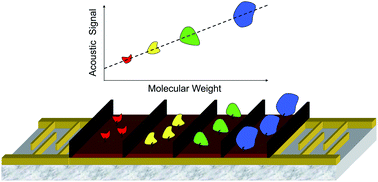Quantitative determination of protein molecular weight with an acoustic sensor; significance of specific versus non-specific binding†
Abstract
Surface acoustic wave sensors with integrated microfluidics for multi-sample sensing have been implemented in this work towards the quantitative correlation of the acoustic signal with the molecular weight of surface bound proteins investigating different interaction/binding conditions. The results are presented for: (i) four different biotinylated molecules (30 ≤ Mw ≤ 150 kDa) specifically binding to neutravidin; (ii) the same four non-biotinylated molecules, as well as neutravidin, adsorbing onto gold; and (iii) four cardiac marker proteins (86 ≤ Mw ≤ 540 kDa) specifically binding to their homologous antibodies. Surface plasmon resonance was employed as an independent optical mass sensor. A linear relationship was found to exist between the phase change of the acoustic signal and the molecular weight of the proteins in both cases of specific binding. In contrast, non-specific binding of proteins directly onto gold exhibited no such linear relationship. In all three cases phase change was correlated with the bound mass per area. The underlying mechanism behind the different behavior between specific and non-specific binding is discussed by taking into account the geometrical restrictions imposed by the size of the specific biorecognition molecule and the corresponding bound protein. Our results emphasize the quantitative nature of the phase of the acoustic signal in determining the Mw (in the case of specific binding) with a resolution of 15% and the mass of the bound proteins (in all cases), as well as the significance of the biorecognition molecules in deriving the molecular weight from acoustic or optical detectors.


 Please wait while we load your content...
Please wait while we load your content...